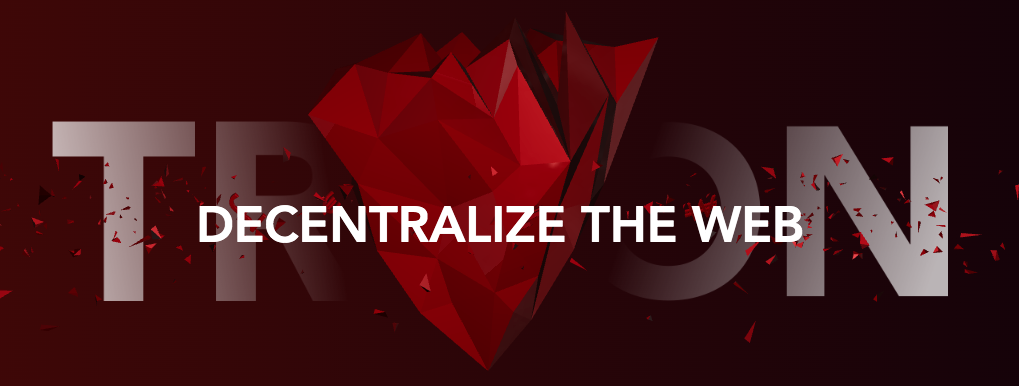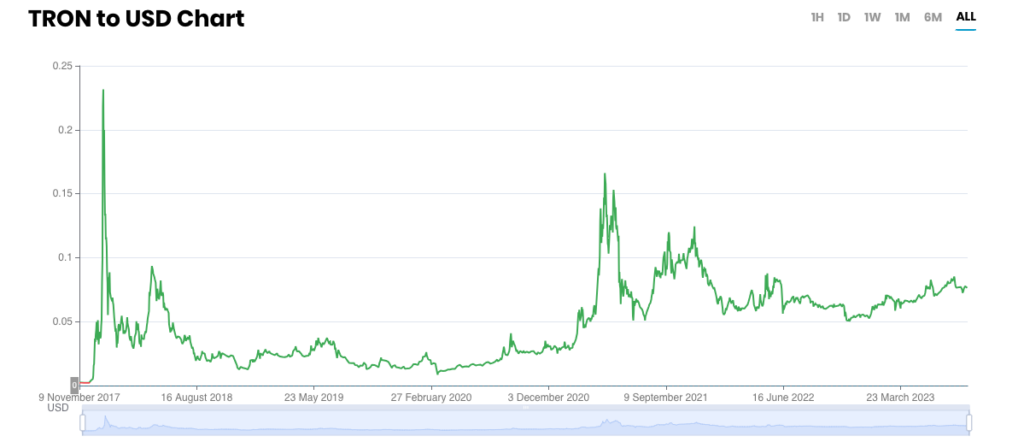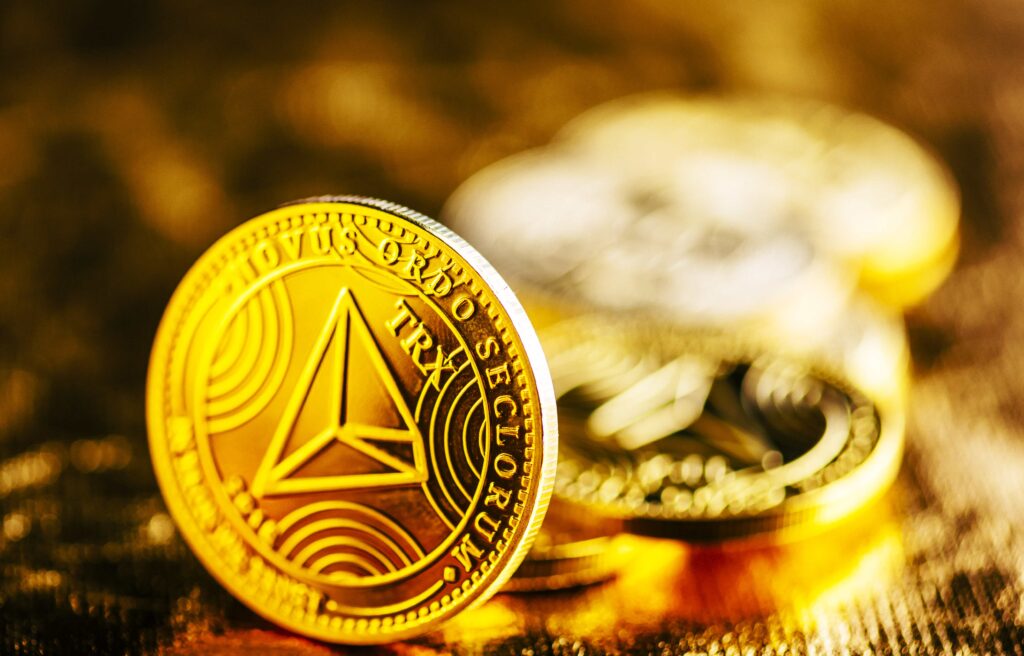TRON Price Data
The live TRON price today is $0.11042100 with a 24-hour trading volume of $582,963,294.
We update our TRX to USD price in real-time. The price of TRON has changed 1.37% in the last 24 hours.
Currently, TRON is the #15 largest cryptocurrency by market cap, with a live market cap of $9,696,526,815.00. It has a circulating supply of 87,604,409,994 TRX coins but the maximum supply is not available.
See where to buy TRON or use our TRON Profit Calculator to calculate and track the performance of your investment.
Tron at a glance
Tron aims to revolutionize the way digital entertainment and content distribution occur, by providing a decentralized ecosystem for content creators, developers, and users.
A Beginner’s Guide to Tron
What is Tron?

Tron is a blockchain-based decentralized platform designed to enable the creation and execution of digital content in a decentralized manner.
At its core, Tron aims to break down barriers between content creators, be it artists, musicians, or even bloggers, and the consumers of their content.
Central to Tron’s ecosystem is its native token, Tronix, known by the ticker symbol TRX. While TRON and TRX are often used interchangeably, it’s essential to clarify their distinct roles.
TRON signifies the overarching blockchain network that powers the entire system, while TRX serves as the cryptocurrency fueling the network’s operations.
What Determines Tron (TRX) price?

The price of Tron’s native TRX is determined by the following factors:
- Intrinsic Link to Network Usage: At the heart of TRX’s valuation lies its direct connection to the activity on the TRON network. The more users engage with the network, the higher the volume of transactions, resulting in increased demand for TRX.
This demand-supply relationship is integral to the cryptocurrency’s price movement.
As more participants utilize TRON’s capabilities for content creation, distribution, and interaction, the value of TRX may experience upward momentum.
- Distribution and Ownership: Around 45% of the total TRX supply is held by the founder, affiliated companies, and the TRON project itself. This concentrated ownership can occasionally influence short-term price movements.
The remaining 55% of TRX is distributed among investors and network participants, effectively distributing the power to influence the price among a wider community. The decisions and trading activities of these stakeholders can significantly impact TRX’s market value.
- Symbiotic Relationship with the Crypto Market: TRX’s value is intertwined with the broader cryptocurrency market. Positive trends and widespread adoption in the cryptocurrency ecosystem can create a favorable environment for TRX to thrive.
As investors and traders become more comfortable with digital assets, including well-established cryptocurrencies, their interest in TRX can increase. Conversely, downturns in the market can exert downward pressure on TRX’s value.
Tron Price History

The inception of TRX coincided with the cryptocurrency boom of late 2017, leading many to see it as a potential “next Bitcoin.”
During its initial coin offering (ICO), TRX was introduced at a modest price of $0.0019. The coin’s journey since then has been one of both exhilarating highs and humbling lows.
How Tron works

The elegance of TRON’s functionality lies in its meticulous three-layer architecture, designed to foster efficiency and speed within its network.
Layered Efficiency: Hosting, Core, and Applications
TRON’s intricate network operates within a carefully crafted three-layer architecture, each with a distinct purpose:
- Hosting Layer: This layer serves as the foundation where participants interact and demand various resources. It’s here that transactions are initiated, and content creators, developers, and users interact. The division of layers streamlines transaction processing, contributing to the network’s speed and responsiveness.
- Core Layer: At the core lies the intricate machinery that processes and validates transactions. Notably, TRON adheres to protocols reminiscent of Google’s approach, enabling seamless support for diverse language extensions. This inclusivity paves the way for a broader range of participants to engage with the TRON network.
- Applications Layer: The pinnacle of TRON’s architecture hosts the applications and services that users enjoy and benefit from. This layer facilitates a diverse array of functionalities, making TRON a versatile ecosystem where various use cases can thrive.
Speed and Scalability: TRON’s Distinct Advantage
One of TRON’s standout features is its exceptional transaction speed. While the Bitcoin network manages approximately six transactions per second, TRON elevates the scale dramatically by processing up to 2,000 transactions per second.
Consensus Mechanism and Super Representatives
TRON’s validation consensus mechanism revolves around a select group known as “super representatives.”
Chosen by the community through elections held every six hours, these super representatives play a crucial role in generating new blocks within the network. In return for their contribution, they are rewarded with TRX tokens.
Every three seconds, a new block is generated, and each block yields rewards of 16 TRX for the participating super representatives.
This incentive-driven approach not only ensures the network’s security and stability but also motivates participants to actively engage in the validation process.
Democratic Governance: TRON DAO
The TRON Decentralized Autonomous Organization (DAO) empowers users to actively shape the network’s trajectory.
Through the DAO, users can vote for super representatives, enabling them to wield influence over network modifications.
This democratic approach underpins TRON’s commitment to creating a dynamic, scalable, and sustainable ecosystem that resonates with the community’s aspirations.
Empowering Participation: Super Representatives and Beyond
Ambitious users with 9,999 TRX can vie to be super representatives, aiming to be part of the esteemed group of 27.
Those ranking from 28th to 127th are acknowledged as members with the privilege of initiating proposals.
However, only super representatives possess the voting authority needed to approve these proposals.
Intricately woven into TRON’s operational fabric, this structure encourages community involvement and empowers stakeholders to influence the network’s evolution.
What is Tron used for?
TRX, the lifeblood of the TRON network, serves as a pivotal tool in fulfilling the network’s ambitious mission: forging connections between content creators and their audiences, all while challenging established giants like Google, Microsoft, Facebook, and Amazon.
TRON’s white paper outlines six stages, which determine its usefulness:
- Exodus: Anchored in simple yet distributed file sharing, this stage underscores TRON’s commitment to enabling seamless content dissemination, laying the foundation for its subsequent advancements.
- Odyssey: Embarking on a quest to discover and empower early platform contributors through economic incentives, TRON sets the stage for a community-driven ecosystem where creators are valued and rewarded.
- Great Voyage: This stage highlights the optimization of smart contracts, enhancing their efficiency and privacy. This leap forward in contract functionality paves the way for diverse applications.
- Apollo Star: TRON’s innovation reaches new heights as content creators gain the ability to mint their own tokens on the network. This empowering feature democratizes token creation and distribution.
- Trek: A strategic foray into the gaming industry signifies TRON’s commitment to supporting and revolutionizing this dynamic sector, tapping into new realms of creativity and engagement.
- Eternity: Culminating in a vision of maximal returns for investors and currency stability, this final stage envisions TRX’s integral role within the gaming world, where its utility is expected to shine brightly.
Some examples of successful projects developed within the TRON network are:
- SunSwap (cryptocurrency exchange).
- JustLend (DeFi lending project)
- Blockchain Cuties (gaming)
- Luminous (betting platform)
- Forsage (marketing)
Who is the Founder of Tron?

Tron is the brainchild of Justin Sun, a Chinese cryptocurrency entrepreneur, who brought the TRON concept to life in 2014. The project was launched in 2017 by the TRON Foundation.
The structure of Tron has evolved over time. Originally centralized around the TRON Foundation, a pivotal shift occurred as the foundation dissolved, and management of the cryptocurrency transitioned to a Decentralized Autonomous Organization (DAO).
This DAO operates through a decentralized framework, a community-driven endeavor that empowers stakeholders to collectively contribute to the network’s growth.
What makes Tron unique?
Tron owes its uniqueness to the following factors:
- Independent Blockchain Network: Unlike its earlier days as a token built atop the Ethereum blockchain, TRON has evolved into a fully-fledged blockchain network with its own protocol. This independence empowers TRON with greater autonomy, control, and the ability to customize its features to best cater to its community and use cases.
- USDT Dominance and Market Presence: TRON boasts an impressive stronghold on the market, with its integration of USDT (Tether), the world’s leading stablecoin, contributing to over 50% of its transactions. This dominance solidifies TRON’s role as a pivotal player in the broader cryptocurrency ecosystem, enhancing its versatility and accessibility.
- High Throughput and Low Costs: A standout feature of TRON lies in its exceptional transaction processing capabilities. With a throughput of up to 2,000 transactions per second, TRON’s network excels in handling high volumes of transactions swiftly and efficiently.
Moreover, the network’s architecture ensures low transaction costs, making it an appealing choice for users seeking cost-effective solutions.
- Empowering Content Creators: One of TRON’s defining characteristics is its commitment to rewarding content creators for their contributions. By incentivizing participation within the network, TRON establishes a nurturing environment where creators are valued and encouraged to contribute to the ecosystem’s growth.
- Custodial Staking and Flexibility: TRON’s staking mechanism offers a unique twist. It allows users to engage in staking while retaining full custody of their funds. This approach strikes a balance between security and participation, empowering users to contribute to the network’s health without relinquishing control over their assets.
How is Tron secured?
Here are key components of Tron’s security:
- Consensus Mechanism: Tron employs a consensus mechanism known as Delegated Proof of Stake (DPoS). In DPoS, a group of elected validators, known as “Super Representatives” on the Tron network, are responsible for confirming transactions and adding them to the blockchain.
This approach enhances security by reducing the risk of centralization while ensuring fast transaction speeds. Super Representatives are selected based on their stake and the number of votes they receive from the Tron community.
- Super Representatives and Block Production: Super Representatives play a pivotal role in maintaining network security. They are responsible for validating transactions and creating new blocks.
To become a Super Representative, participants must stake a significant amount of TRX (Tron’s native cryptocurrency) and earn the trust of the community. This stake acts as collateral, motivating Super Representatives to act honestly and responsibly.
- Regular Network Upgrades and Bug Fixes: Tron’s development team continuously works to enhance the network’s security by releasing regular updates and bug fixes. These upgrades are designed to address vulnerabilities, improve performance, and implement new features.
The community is encouraged to actively participate in reporting potential security issues, ensuring a collaborative effort to maintain the network’s integrity.
- Resource Management and Bandwidth: Tron implements a resource management system to prevent network abuse and congestion. Users must allocate a certain amount of TRX as bandwidth and energy resources for executing transactions and smart contracts. This approach prevents malicious actors from overwhelming the network with spam or denial-of-service attacks.
- Smart Contract Security: Tron allows the creation and execution of smart contracts on its blockchain. To ensure the security of these contracts, developers are encouraged to follow best practices, conduct thorough audits, and engage with the Tron community for peer reviews. Tron’s network is designed to minimize vulnerabilities in smart contracts through careful design and rigorous testing.
FAQs
Can Tron be Mined?
TRON uses a Proof of Stake consensus mechanism to develop its network. Hence it cannot be mined.
Who created TRON?
Tron is the brainchild of Justin Sun, a Chinese crypto entrepreneur. The TRON Foundation has managed the network since 2017, the year of its official launch.
Does TRON support NFTs?
Yes, TRON’s network supports NFTs, in fact, they are a large part of content creators who choose their network to connect with their audience.



